An explanation of what I'm doing here can be found in my introduction post.
Last week we looked at Romance of the Three Kingdoms IV: Wall of Fire, Descent, In the Hunt, and Magic Carpet.
This time we're closing out March '96 with Wing Commander III: Heart of the Tiger, Road & Track Presents: The Need for Speed, Extreme Pinball, and Resident Evil.
**This post is also featured on my site, fifthgengaming.blog, and can be found here.**
----------------------------------------------------------------------------------------------------
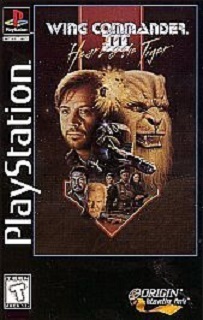
Wing Commander III: Heart of the Tiger
Developer: Origin Systems
Publisher: Origin Systems
Release Date: 3/15/1996
Time to Looking Up The Manual And Restarting: 30 Minutes
Time to Being A Pathetic Descendent Of Monkeys: 2 Hours
This game feels more important than it probably is. For the uninitiated, this is the third entry in the Wing Commander series of story-heavy Space Sims, done in the classic style. That style leans heavily into the sim part of the genre, erring on the side of fiddly, complex controls that only a Steel Battalion fan could love. This third entry was originally released for the PC in '94, and it shows. We'll get to the in-game graphics later, but the immediately obvious thing is that the story picks up and goes with the assumption that the player is fully knowledgeable of the events from the previous games and expansions.
I personally dislike the phrase 'Space Opera.' Partially because operas are dull and you shouldn't call something that if there isn't singing, but mainly because that label strains under decades of redefinition and broadening. The term has arrived at the present day with so little meaning that any story with a spaceship could be called a Space Opera. The only qualifications for a work of fiction to fall under that label are to be set in space and not be overtly comedic. It's a useless genre classification and the name doesn't describe its meaning in any understandable way, if such meaning even exists. That said, Wing Commander III is a textbook example of a Space Opera.
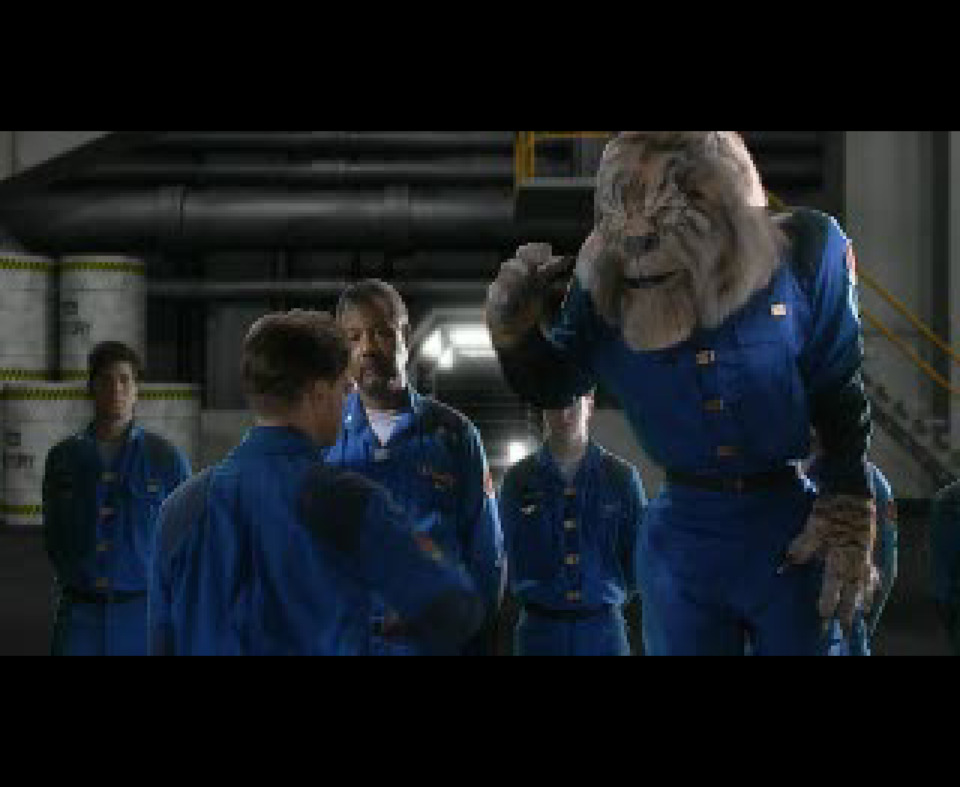
You play as the series protagonist Colonel Blair (Mark Hamill), who gets reassigned to be the wing commander of an old shitbox space carrier by the perpetually hostile Admiral Tolwyn (Malcolm McDowell) after the ship from the last game is wrecked. Blair's love interest from the previous game (Yolanda Jilot) is being held in captivity by the bad guys and is thus a non-entity. The other pilots In Blair's new wing all have personalities and are fully acted, the most recognizable ones being portrayed by Tom F. Wilson and Francois Chau. The ship's captain (Jason Bernard), comms officer (Courtney Gains), and chief mechanic (Ginger Lynn Allen, if you're old enough to recognize that name don't forget your CPAP tonight) are also featured prominently. There's a metric ton of FMV featuring all these people, which I would call the most competent I've seen so far in spite of the laughably bad CG sets.
The plot itself follows these characters at the end of a decades-long war between the human Confederation and a space empire of large cat people called the Kilrathi. There are twists and turns, including a lot with the one Kilrathi crewmember who is totally not a Worf knock-off. None of this carries as much weight as the game would want, in part because everything has to lead to space combat missions. Blair inherently isn't going to go face-to-face with the villains because of the gameplay constraints. It should also go without saying that the dialogue is bad, but I've seen worse from modern games so I'm not going to get hung up on it. The live action scenes are shot competently, and the actors do what they can with the material, which in 1994 would have been the best yet seen in a video game.
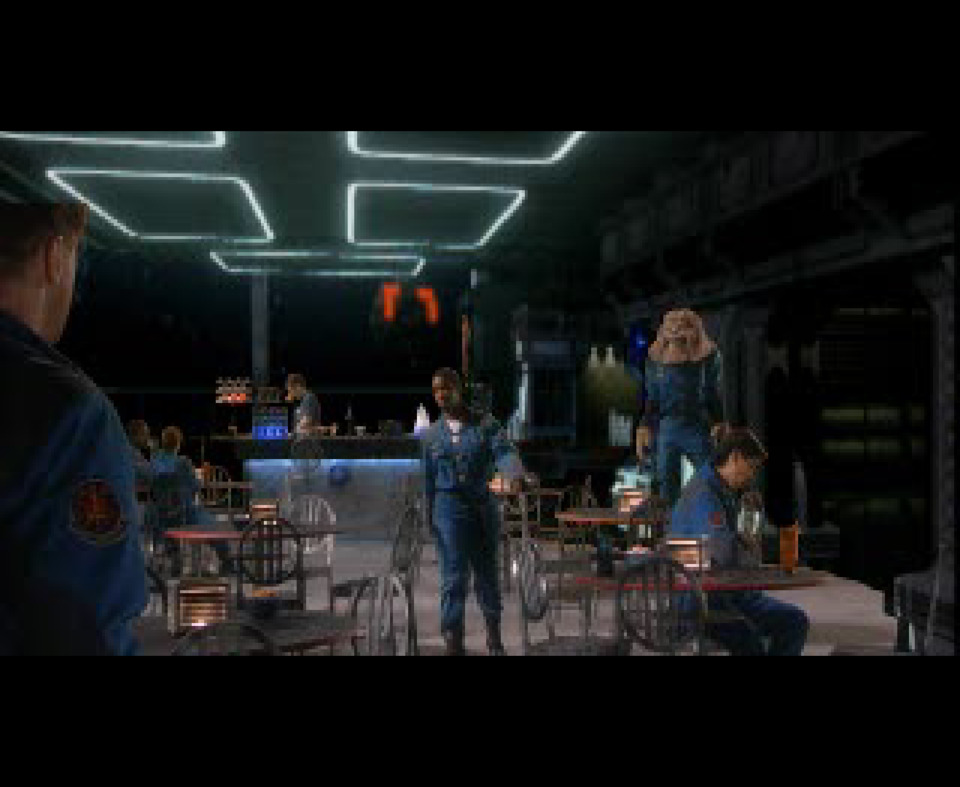
The game which this is all wrapped around is a technical Space Shooter where you fly a fighter on missions to shoot various things for various reasons. The first four missions I did were two patrols and two escort missions, but from what I know there are planetary bombings, capital ship battles, boss fights, and probably a few more types later in the game. You fly those missions at a cadence that would be familiar to anyone who's played a Bioware game in the last 20 years. You click between screens on the carrier for cutscenes, go into a mission, return, and repeat. You can bring one of the other pilots as your wingman on missions, with each apparently having their own AI quirks that are influenced by how you interact with them on the ship. Those wingmen can also get killed off after certain story points if things go sideways, though from what I've read most of them get killed off in the story no matter what. There's a lot of nuance with the systems here for a game in the mid-90's, which is commendable.
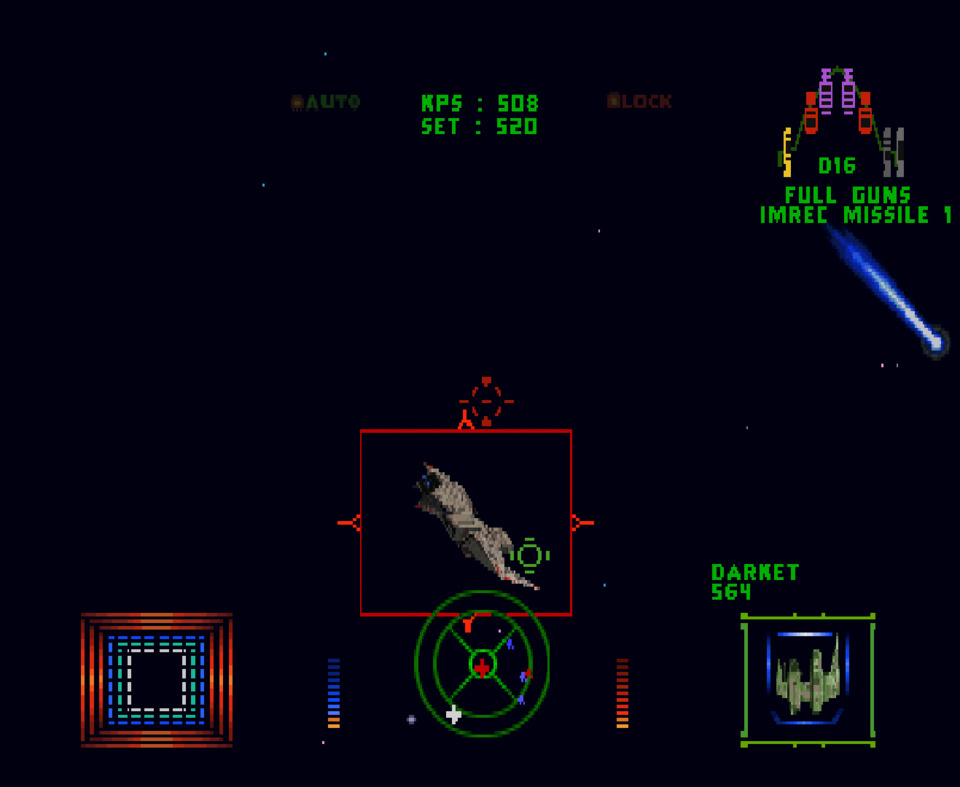
What isn't commendable is the control scheme. Jesus fucking Christ these controls. Since this was originally a highly technical PC game, there were more input buttons than are available on a PS1 controller. This is true of most PC games, and each has had varying degrees of luck in making the adaptation. Origin seems to have been unwilling to compromise on the depth of control options for this port. Can you guess how many unique button inputs there are for the space missions? When I say 'button input' I'm talking about a unique action that is taken when pressing a button or simultaneous combination of buttons, e.g. if Square and Triangle both do the same thing then that's only one input, and if L1+Cross does something different than L1 or Cross individually then that counts as its own separate input. With that in mind, how many inputs do you think there are? I have the game manual open in front of me and I lost track at 38. There are 14 total buttons on the controller, which averages out to about 2.7 inputs for every button. You literally have to hold the select button while using the d-pad to access necessary functions. Learning and keeping track of all the various finger contortions necessary to play this thing presents a massive and immediate learning curve.
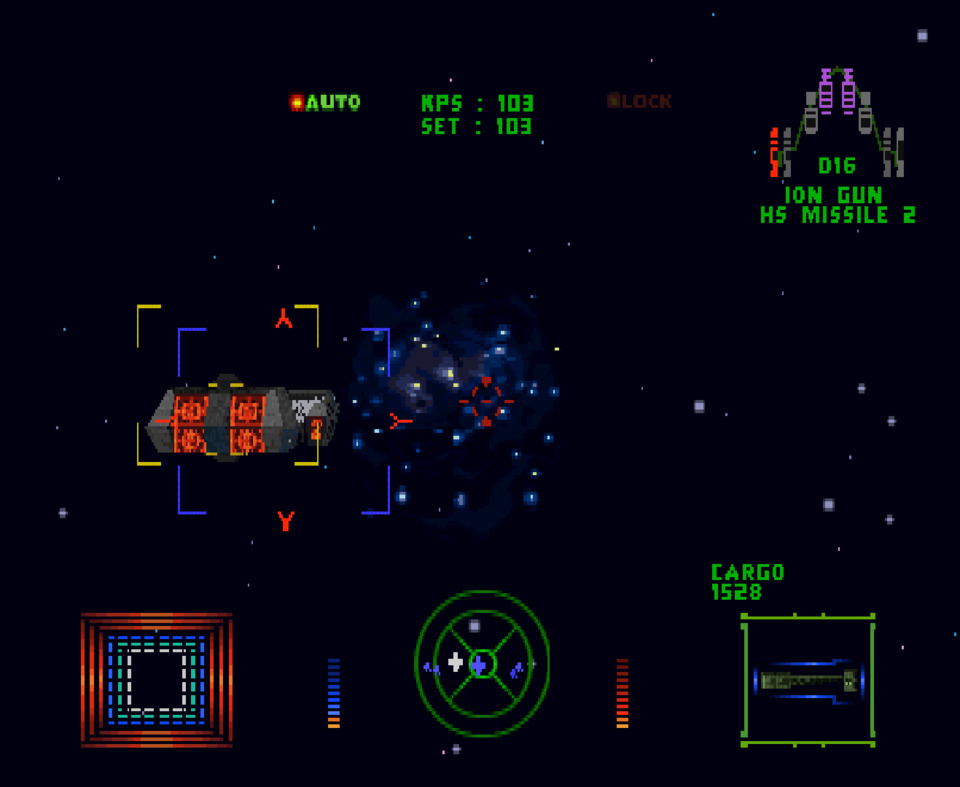
The truly twisted thing is that once you wrap your head and other extremities around the controls, the game is completely fine. There are wide ranging difficulty options that seemingly let anyone of any skill level get through the game, which is extremely humanistic for the time, though I imagine Origin would want players to see the cutscenes that they put so much effort into. The game will also let you continue forward when you fail a mission, which seems to be a series staple. This is a very early example of having Your Choices Matter™ in video games, which is impressive for the time. Now, cramming all this into a game is going to have one important consequence, in that this thing is almost 2 Gb in size. The fucker comes on five CDs, which should be an illegal number of discs for a PS1 game. This thing is massive, and with the different difficulty options and dialogue paths there would have been real replay value for anyone who bought it.
Wing Commander III is a complete enough experience that it invites a higher level of critique than other games we've seen so far. I've been giving games from this era significant handicaps in my evaluations. If I'm being honest, a lot of these things are shallow, disposable amusements or only one step above children's toys. That's just the way video games were back in the day, and most of these are at best mediocre by modern standards. This game, though, has enough to bite into that it's hard to not judge it by more advanced expectations. The issue is that it doesn’t really meet those expectations. The world building is sloppy and incoherent, the characters are one-dimensional, the controls are convoluted, the acting is hit-and-miss, the gameplay has uneven pacing, it isn't visually interesting, and it lacks the depth of system interdependency that we would expect from something that feels like a cross between Mass Effect and Elite Dangerous. Of course, this is an ancestor to modern Bioware-style RPGs and Space Sims, but it gets close enough that it's too easy to compare this thing with games 10 or 20 years its junior.
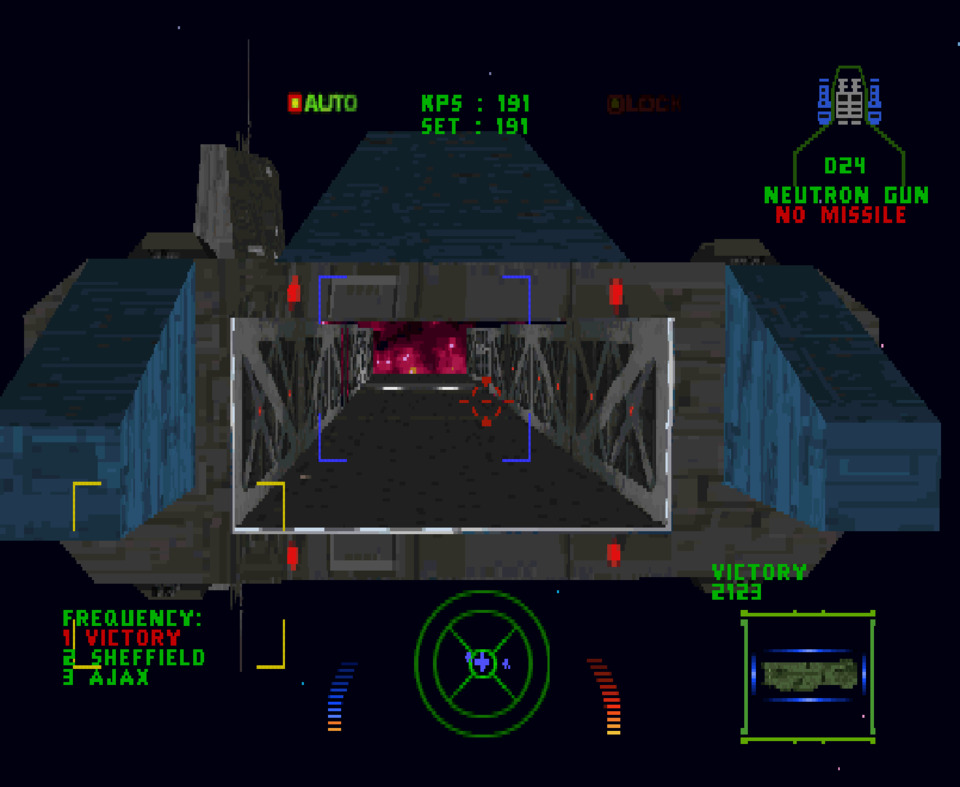
After all that, you would think this thing is super important in the history of video games, but it kinda isn't. The Wing Commander franchise started in 1990, burned brightly by the standards of 90's PC gaming, and flamed out by the year 2000. This is partially due to the series creator and director, Chris Roberts, pulling a Sakaguchi and flaming himself out on an ill-fated Hollywood production. The basic game structure from this series would be done better by Bioware later in the 2000's and Space Sims would recede into semi-obscurity until well into the 2010's. Wing Commander has almost no legacy to speak of in our current day, outside of odd trivia about Mark Hamill's filmography. I don't know what to make of that.
----------------------------------------------------------------------------------------------------

Road & Track Presents: The Need for Speed
Developer: EA Canada
Publisher: Electronic Arts
Release Date: 3/20/1996
Time to Winning Literally Anything: 55 Minutes
This is the first time I've ever seen or touched this game, and now that I have, I'm mildly furious that it spawned a long-running franchise. This was such a maddening experience, and it didn't deserve any sequels.
Road & Track: The Game is a straightforward Sim Racing game in the pre-Gran Turismo style. There are eight cars that can be raced on six tracks in time trial, head-to-head, single race, and tournament modes. The big draw here is the Road & Track partnership. Each of the cars is lovingly cataloged, with detailed interiors and car noises. Really, this experience is two different things crammed together. Aside from the racing, there's a whole menu that takes you through different narrated stat screens and video clips for each car. This stuff in unabashed car porn, and the guys who made this would have fucked these vehicles if they could have gotten away with it.
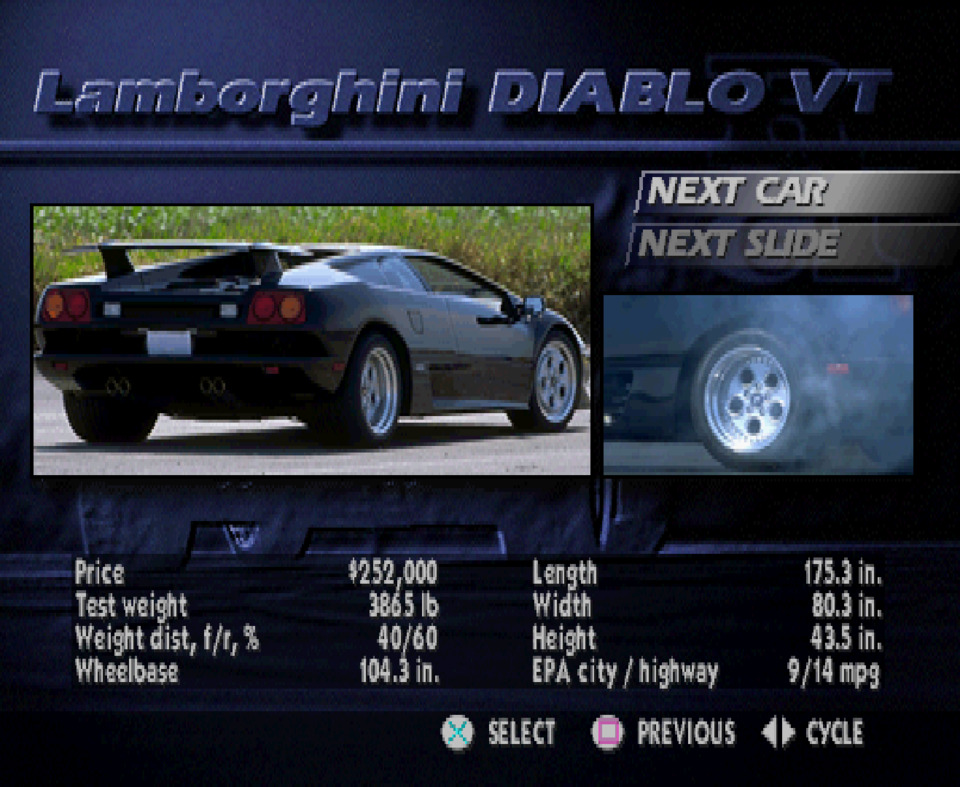
The racing itself is extremely technical. What I mean is that, being a sim, it expects you to learn the ideal lines through the different tracks and the braking points for each car type to take those lines. You literally cannot win a race if you don't do this. Since this originally came out for the frickin' 3DO in 1994, there are zero concessions to tutorialization or quality of life; you gotta git gud, bitch. There are no difficulty settings or different race difficulty tiers. Ridge Racer only has one track and it even has a difficulty on-ramp. There's no excuse for this horseshit. Just about every other racing game on consoles at the time were more fun than this thing.
It turns out that the Time Trial mode is the most enjoyable part of the game. This is possible because the actual driving model feels basically fine. The handling is supposed to be as realistic as they could get in '94, the interior views look nice, and the sound effects are probably the best they could do at the time, which makes this the opposite of High Velocity. This is to the point that grinding up against a guardrail actively caused me to wince because of the believable metal-on-metal screeching. The developers also seem to have figured out the trick to not having pop-in, which is always to a game's merit. Not to the game's merit are the car models, which would have been advanced for the time but look hilarious now. Finally, the soundtrack consists of bad butt rock, which I guess also makes this the opposite of Road Rash which had good butt rock.
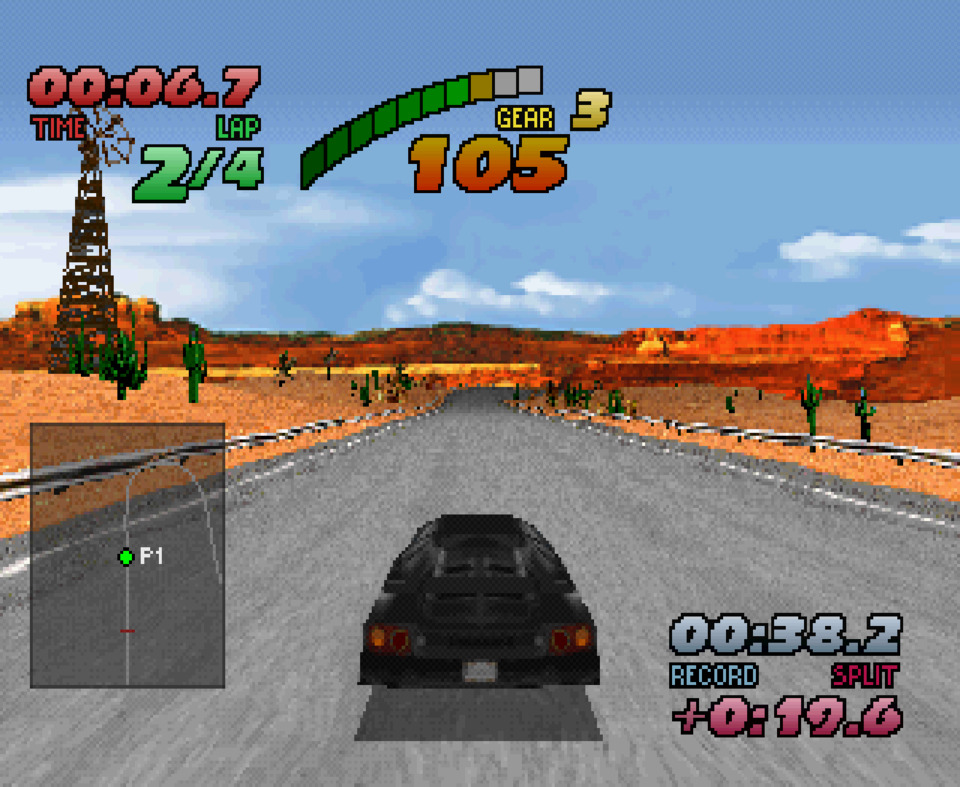
Need & Speed Presents: The Road for Track apparently sold really well, presumably because motherfuckers had no taste. This might have been the worst racing game for Playstation at the time of its release, which is why it generally reviewed well. This was all successful enough to inspire a sequel in '97 and then damn near every subsequent year until 2013, when it moved to an every-other-year cycle. I generally like the modern Need for Speed games and Razor Callahan is a vital part of gaming history, but holy crap was this first game not deserving of a sequel.
I've been cooking up something to do with this franchise, irrespective of this review. So, stay tuned for more on that at some point in the near future.
----------------------------------------------------------------------------------------------------
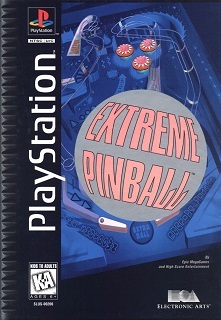
Extreme Pinball
Developer: Epic MegaGames
Publisher: Electronic Arts
Release Date: 3/28/1996
Time to Gutter Ball Or Something I Don't Know: 26 Minutes
Now we get to be subjected to the PS1's first Pinball game. Somehow, this thing has accomplished something that I never wanted to see: it's worse than Last Gladiators.
Extreme Pinball originally came out for PCs in 1995 and received as lukewarm a reception as was possible. Following that rousing success, it was ported to the PS1 and was rewarded with an actively hostile reception. So, this is memorably bad, right? Nope. There are four pinball boards, none of which are particularly interesting in either their functional or visual design. Unlike Last Gladiators, the camera is super zoomed in like a GBA pinball game, which creates an opposite set of problems. When the ball really gets going and shoots straight downward, there is extremely little time to react once the camera pans to the bottom of the table. Also, the physics feel wrong in ways that I can't properly express.
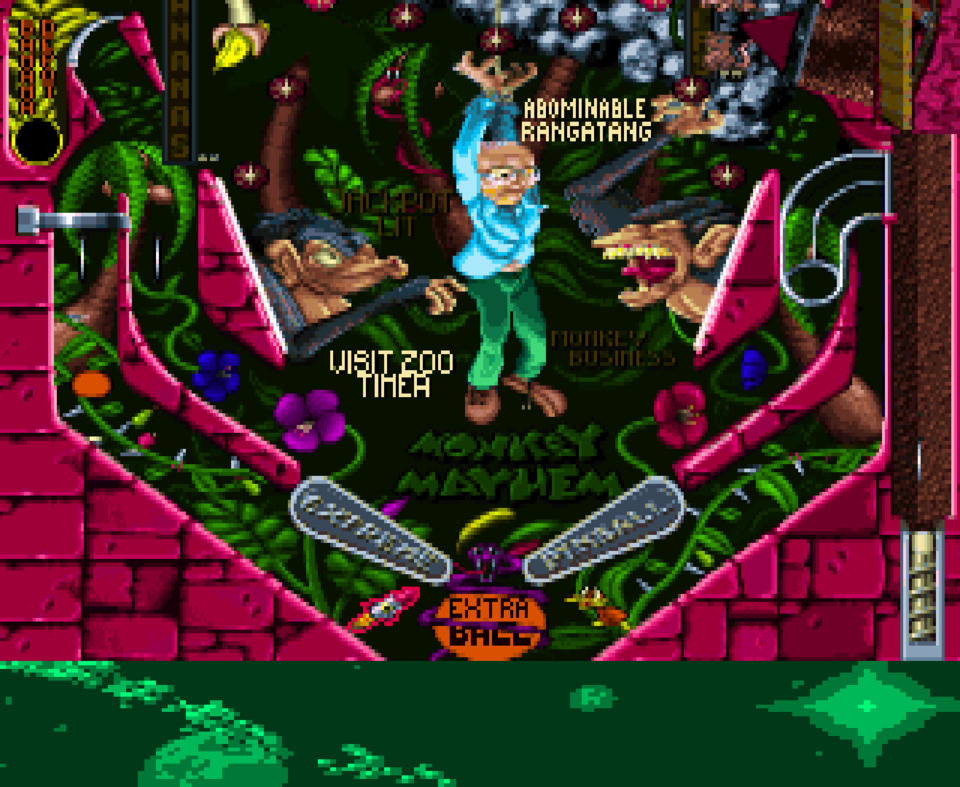
There are a handful of fanciful effects that wouldn't be possible on a real table, which I guess gives this thing one up on Last Gladiators. Yet, the flow of the action and overall layout of the boards feels amateurish and poorly thought out, which is the last thing you would want in a Pinball game. There's very little going on in this package, there aren't even pre-filled high scores to play against. If I had to rank the tables on offer, they would be: Monkey Mayhem, Urban Chaos, Medieval Knights, Rock Fantasy. That last one is surprisingly abysmal.
Truly an uninspiring first console release for the co-developers Digital Extremes and Epic MegaGames. Epic especially hasn't put out anything of value before this point, unless you're some kind of Jazz Jackrabbit sicko, and I don't think that group of chuckleheads will ever amount to anything.
----------------------------------------------------------------------------------------------------
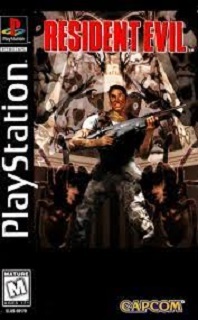
Resident Evil
Developer: Capcom
Publisher: Capcom
Release Date: 3/30/1996
Time to Becoming A Jill Sandwich: 20 Minutes
We're closing out this season of PS1 games with something that feels less important than it actually is. This game was a commercial and critical phenomenon and was the first true mega-hit for the system, to the point that it is apparently the 17th best-selling Playstation game of all time. This thing will go on to spawn a truly massive media franchise with not only its direct sequels, but also more spin-offs, movies, and novelizations than is advisable. I'm not being particularly hyperbolic by saying this is the point when the PS1 era really began. Not just because of the popularity, but also the impact this thing had on 3D game design standards going forward. Resident Evil is massively influential on every level. I also despise playing the goddamned piece of shit.
For anyone who has spent the last 30 years in a coma, the premise of the game is that you play as a special, SWAT-adjacent cop from Raccoon City. Your team helicopters out to the middle of the woods looking for a cannibal cult, gets attacked by zombie dogs, and ends up in a spooky mansion. Everyone splits up immediately, and you have to uncover the evil nature of the mansion's residents while fighting zombies, biomonsters, oversized creepy crawlies, and obnoxious inventory puzzles. The opening FMV is probably the greatest nonsense in the history of video games; it's a full blend of stupid, half-assed, sincere, and bizarre creative decisions and it's perfect. The English language text and voice acting in the rest of the game is famous for being terrible in every way, which it absolutely is. All the plot and character work in this thing are delightfully stupid, and the best part is that I can't tell whether or not it's intentional.
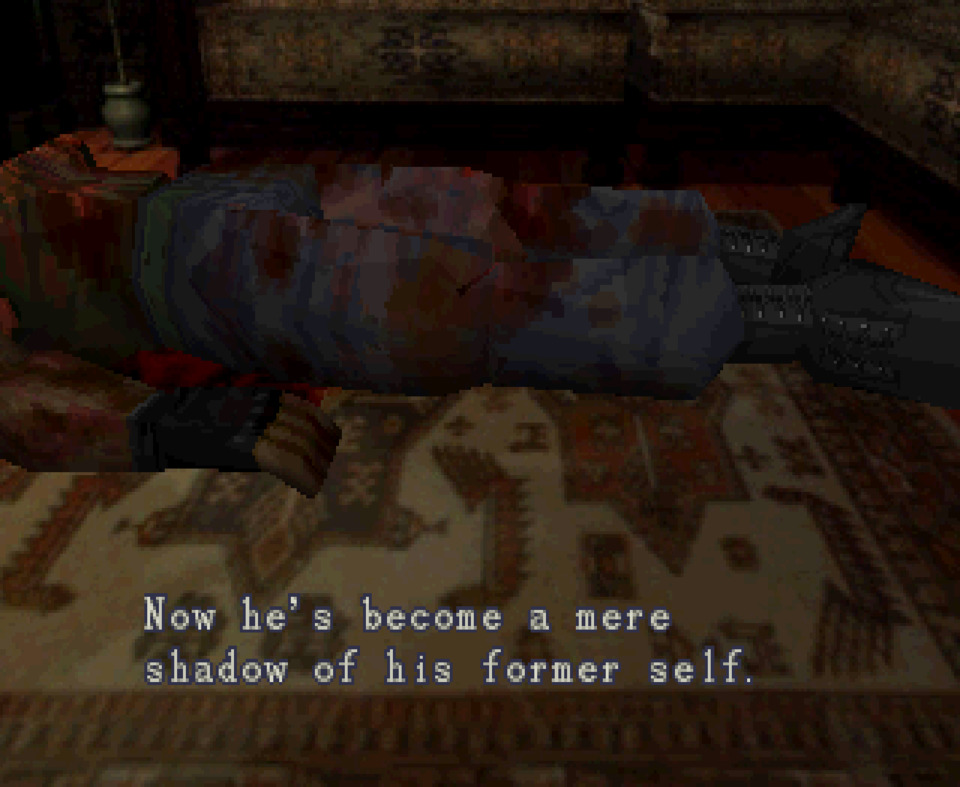
Though, the story is probably supposed to be at least a little scary. I'm assuming that because everything else about the visual, audio, and game design are geared to elicit as much fear, dread, and shock as possible. The biggest feature here is the fixed camera angle that changes room-to-room and screen-to-screen. It's a very clever way to integrate pre-rendered graphics with action gameplay in a way that reinforces the setting and atmosphere. There are like a thousand video essays out there breaking down the specifics of how the layout, art, sound, music, camera, and puzzle design reinforce the driving need to stress out the player in both subtle and overt ways. I don't want to relitigate any of that, and even if I did, I lack the pretentious video essay voice to pull it off.
What I will litigate here is the controls and overall feeling of trying to play the thing. This is supposed to be a video game, after all. The game is infamous for its 'tank control' scheme, which I won't dig into as a label or concept, which involves using the d-pad to rotate, advance, and reverse the player character respective to the character and not the camera angle. This means that pushing Up on the d-pad will move the character in the direction they're facing and Left will rotate them to their left, whether you're looking at their front or back. Because the camera direction is constantly changing, this control scheme is what you could scientifically call "a real bastard." When I was young and naïve, I thought this was done because people in the 90's didn't know how to make good games. Being older and wiser, I know that they absolutely did and that this nonsense was intentional; the shit controls are supposed to add to the tension.
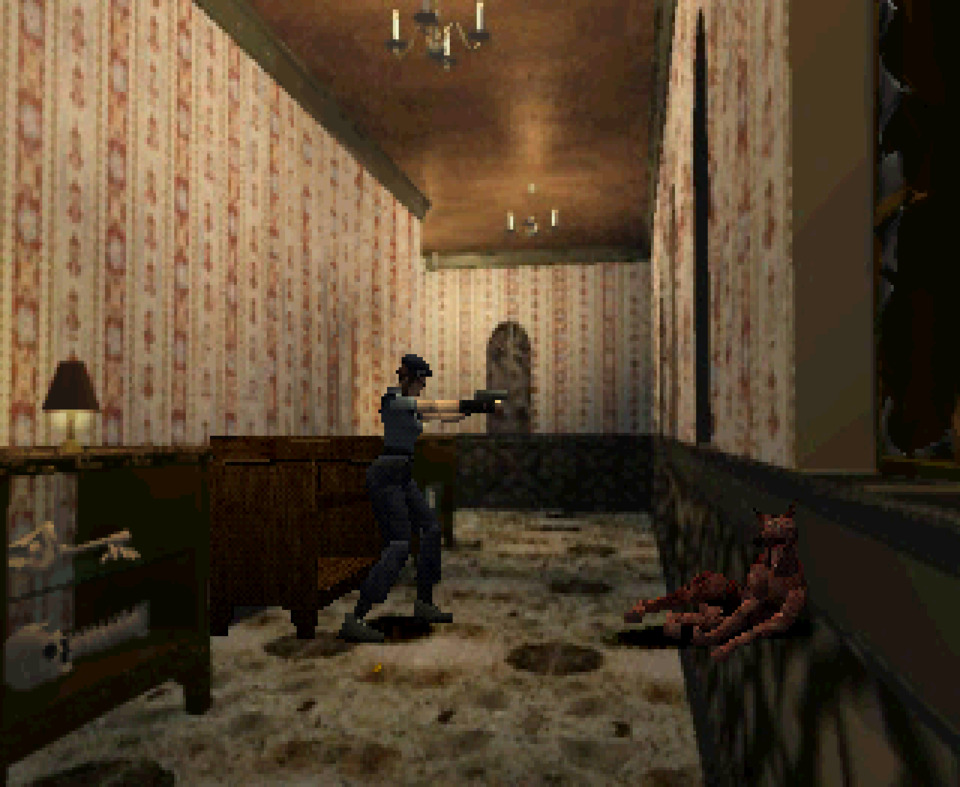
That brings us to the reason why I bounced after 20 minutes with this game: it plays like zombified dogshit. The combat is miserable, the controls are bad, and there is nothing but frustration to be had. I know that's the point, if you're having fun then you aren't scared, in theory. My question is, does being stressful and annoying count as horror? This is put together with great care to make an attempt at interactive Horror, but is this the way to achieve it? Does being generally stressed into a fight or flight response count as experiencing horror? I personally don't believe so, but I also wouldn't call movies that traffic in gross out effects or torture porn as Horror so I'm probably an outlier. People at the time seem to have found this game widely appealing, as it spawned the whole Survival Horror genre. I would guess that the presence of a tangible atmosphere, combined with gameplay that wove together 3D action, puzzles, and storytelling in a detailed, internally coherent environment is what did it. As such, I would credit this game as being the first modern 3D Action game more than anything else, which I also think is more important than popularizing the Survival Horror genre.
Regardless, we're going to be dealing with more games like this, in every sense, from here on out. This is both a blessing and a curse.
----------------------------------------------------------------------------------------------------
That's a wrap for the PS1 in the first quarter of 1996. This feels like the inflection point where things really start to get going for the Playstation, so hopefully it's mostly uphill from here. Let's update the official Ranking of All PS1 Games and see what's next.
1. Air Combat
…
14. Wing Commander III: Heart of the Tiger
28. Resident Evil
44. Extreme Pinball
46. Road & Track Presents: The Need for Speed
…
77. World Cup Golf: Professional Edition
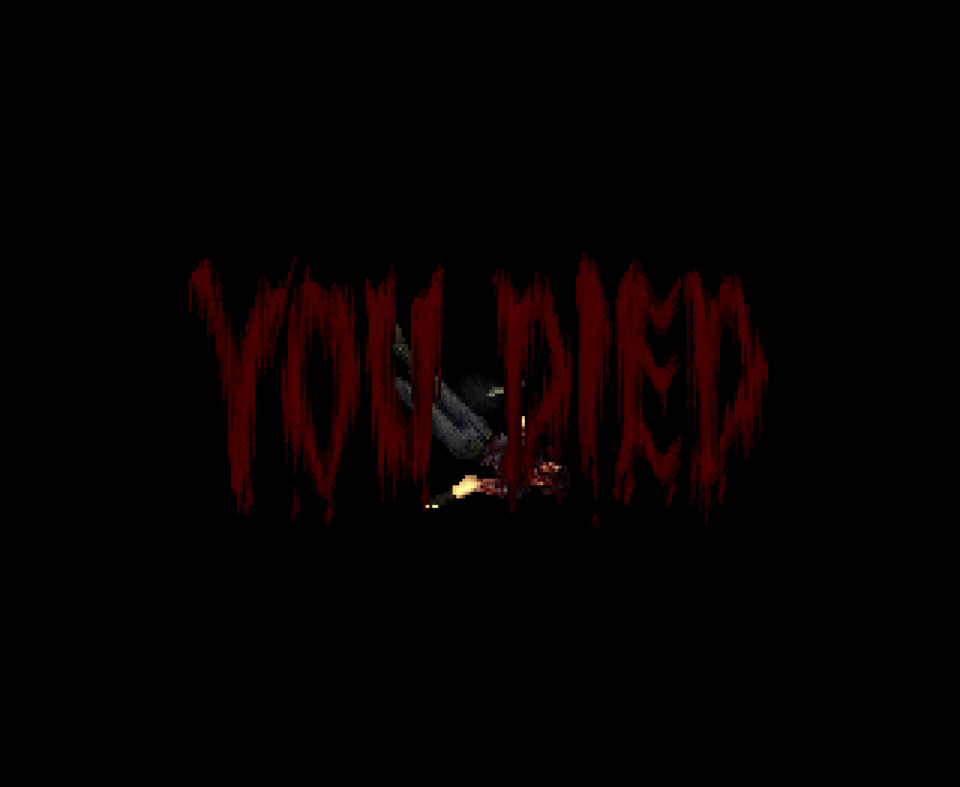
Next time, we're going to switch tracks and rewind back to 1/1/96 to take a tour through the goings-on of the Sega Saturn. That system has 21 releases in the first three months of '96, and it'll take about three weeks to get through it all. Now, the reason I wrote 'next time' instead of 'next week' is that I'm taking next week off to get the next batch of posts spun up. So, let's all meet back here in two weeks for All Saturn Games In Order: January 1996, where we'll come to grips with Wing Arms, NFL Quarterback Club '96, Mortal Kombat II, World Cup Golf: Professional Edition, Darius Gaiden, and Hang-On GP.
But that's not all, before the break I'm still going to publish the last part of All 3DO Games (Kind) In Order for 1993 later this week. In that post, we'll look at Star Wars: Rebel Assault, Stellar 7: Draxon's Revenge, The Life Stage: Virtual House, and Twisted: the Game Show. I'll have an announcement to make at the end of that as well, so don't miss it!
----------------------------------------------------------------------------------------------------
I streamed these games over on my Twitch channel at https://www.twitch.tv/fifthgenerationgaming. The archive can be seen below.
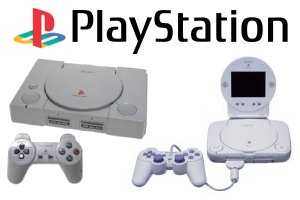
Log in to comment